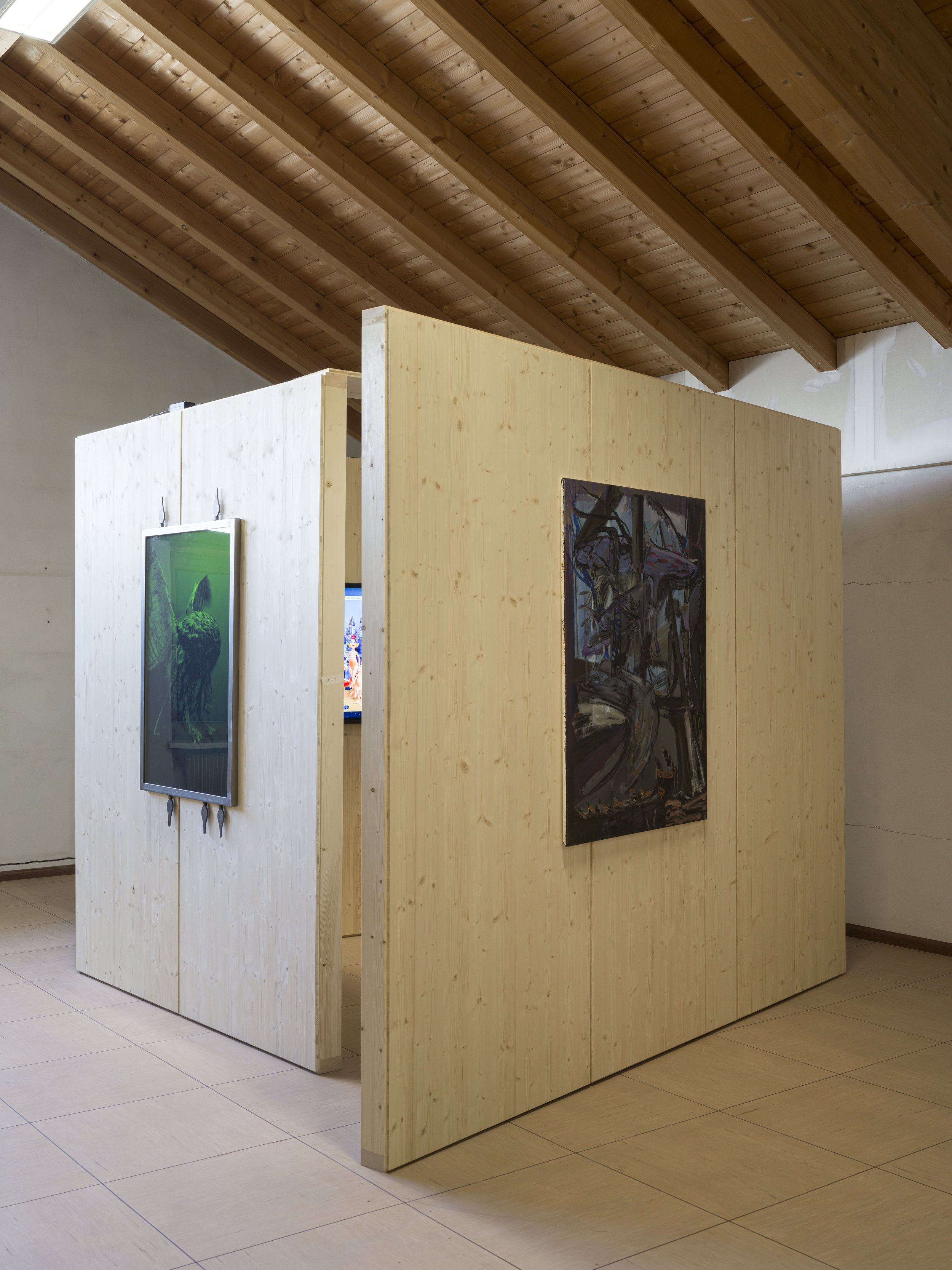
Talar Aghbashian, Installation views at Biennale Gherdëina 9. Photo by Tiberio Sorvillo

EN Lebanese-Armenian artist Talar Aghbashian questions our relationship with the natural landscape through paintings that never represent a specific place, but are rather abstractions of landscapes and ruins. The works, all produced with oil paint on canvas, maintain a certain ambiguity: it is hard to tell whether the subject is a mountain range, a forest or the outline of a city, a volcanic eruption or a derelict building. Some paintings seem to depict lands submerged by water, where the artist imagines a past when mountains were coral reefs, or near-futuresin which glaciers melted by global warming will turn valleys into basins of water.The works on show at Pontives are characterised by a palette that focuses on cold colours – blacks, greys, blues and greens – in which the slow build-up of pictorial layers contrasts with a fast stroke that makes the subjects dynamic and vital. They are populated by figures in which the human form and the landscape are fused into a single entity, poised between the landscape and the human body, united by their being alive. It almost seems as if the artist wishes to invite the viewer not just to contemplate the landscape as a fixed, unchanging entity, but to take part in the life unfolding on the horizon. (Marta Papini)
IT L’artista libanese-armena Talar Aghbashian si interroga sul nostro rapporto con il paesaggio naturale con dipinti che non rappresentano mai un luogo specifico, ma sono piuttosto astrazioni di paesaggi e rovine. Le opere, tutte realizzate con pittura a olio su tela, mantengono una certa ambiguità:difficile stabilire se il soggetto sia una catena montuosa, una foresta o il profilo di una città, un’eruzione vulcanica o un palazzo esploso. Alcuni dipinti sembrano rappresentare terre sommerse dall’acqua, in cui l’artista immagina un passato in cui le montagne erano barriere coralline, o futuri prossimi in cuii ghiacciai sciolti dal riscaldamento globale trasformeranno le valli in bacini d’acqua. Le opere in mostra a Pontives sono caratterizzate da una tavolozza che si concentra su colori freddi, neri, grigi, azzurri e verdi, in cui il lento accumularsi di strati pittorici si contrappone a un tratto veloce, che rende i soggetti dinamici e vitali. Sono popolati da figure in cui la forma umana e il paesaggio sono fusi in un’unica entità, in bilico tra il paesaggio e il corpo umano, accomunati dall’essere vivi. Sembra quasi che l’artista voglia invitare le persone a non limitarsi a contemplare il paesaggio come una entità fissa e immutabile, ma a prendere parte alla vita che si muove all’orizzonte.
DE Die libanesisch-armenische Künstlerin Talar Aghbashian hinterfragt unsere Beziehung zur natürlichen Landschaft anhand von Malereien, in denen sie weniger bestimmte Orte darstellt, sondern vielmehr Abstraktionen vonLandschaften und Ruinen. Die Werke, die alle mit Ölfarbe auf Leinwand gemalt sind, behalten eine gewisse Mehrdeutigkeit bei: Es ist schwer zu bestimmen, ob es sich um eine Bergkette, einen Wald oder den Umriss einer Stadt, einenVulkanausbruch oder ein explodiertes Gebäude handelt. Einige Malereien scheinen vom Wasser überschwemmte Gebiete darzustellen, in denen sich die Künstlerin eine Vergangenheit vorstellt, in der Berge einst Korallenriffe waren, oder eine naheZukunft, in der durch die globale Erwärmung geschmolzene Gletscher Täler inWasserbecken verwandeln werden. Die in Pontives gezeigten Werke zeichnen sich durch eine Palette aus, die sich auf kalte Farben, Schwarz, Grau, Blau und Grünkonzentriert, wobei der langsame Aufbau von Bildschichten mit einem schnellen Strich kontrastiert wird, der die Themen auf dynamische und vitale Weise umsetzt.Die Arbeiten werden von Figuren bevölkert, in denen die menschliche Gestalt und dieLandschaft zu einer Einheit verschmelzen, zu einer Balance der Körper, die durch ihr Lebendig sein miteinander verbunden sind. Es scheint fast so, als wolle die Künstlerin die Betrachter*innen einladen, die Landschaft nicht nur als festes, unveränderlichesGebilde zu betrachten, sondern an dem Leben teilzunehmen, das sich im Bildhorizont bewegt.
LA L’artista libanesc-armena Talar Aghbashian se fej dumandes sun nostarelazion cun l paesaje naturel tres depënc che mostra mei n post spezifich, ma ieplutosc astrazions de paesajes y sedims. L’opres fates dutes cun pitura a uele suntëila mantën nchin a n cër pont formes nia tleres: l ie rie udëi ora sce l soget ie naciadëina de crëps, n bosch o l prufil de na zità, na eruzion de n vulcan o n palazsautà tl aier. N valgun depënc semea mustré grunc curii d’ega te chëi che l’artistase nmaginea n passà te chël che i crëps fova barieres de curëc o n daunì daujinte chël che i dlacieres dleghei dal sciaudamënt sëura dut l mond trasfurmerà lavaledes te resservares dal’ega. L’opres metudes ora a Pontives ie caraterisedes dana brëia dai culëures dantaldut frëic, fosc, grijes, brums linëusc y vërc tres chëiche l se abiné adum bel plan strac de pitures che va contra na rissa aslune che fejdeventé i sogec dinamics y vitei. I vën nridlei da figures ulache la forma umanay l paesaje se à dlegà adum te una na esenz che ie a balanz danter l paesaje y lcorp uman, unfat te si vester vives. L semea belau che l’artista uebe nvië ite lspetadëur a ne se limité nia mé a cuntemplé l paesaje coche n’entità fërma y chene se muda nia, ma a tò pert ala vita che se muev orado.